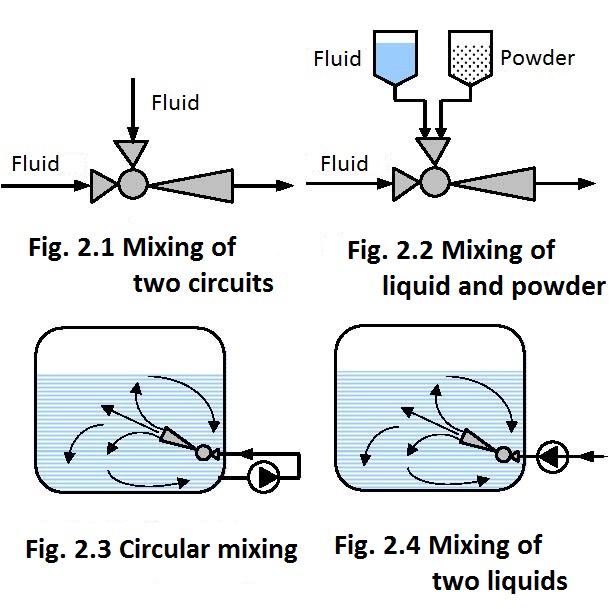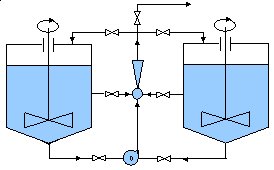EJECTOR MIXERS Division
Ejector mixers are used for mixing liquids, emulsions and suspensions with different physical and chemical compositions. Depending on the fluid being mixed they can be divided into:
- ejector hydro mixers (liquid-liquid)
- ejector gas hydro mixers (gas-liquid)
- ejector vapor hydro mixers (vapor-liquid)
Ejector mixers can be used for mixing gases and vapor (see more detailed data in Ejector gas ventilators, Ejector gas compressors and Ejector vapor compressors).
2.1 Ejector hydro mixers (liquid-liquid)
Ejector hydro mixers enable efficient and homogenous liquid mixing in open and closed vessels. In closed vessels mixing can be performed under low and high pressure, at low or high temperatures with simultaneous heating or cooling
Such a mixing procedure can maintain a uniform temperature and pH value in the mixture and maintain homogenous emulsions and suspensions, prevent division and separation of non-mixing liquids or liquids with different densities.
Application
Ejector hydro mixers are used for mixing all types of liquids, emulsions and suspensions. One or more liquids of different compositions and densities can be mixed at the same time. As a rule all liquids that can be transported with centrifugal pumps can be mixed.
They can be used for mixing two streams – figure 2.1, mixing liquids and small loose materials, powders etc. (figure 2.2). Mixing and mixture maintenance as a homogeneous composition can be performed with circular-circulating movement (figure 2.3) or using external gas or liquid (figure 2.4). In large reservoirs, vessels and mixers several ejectors can be installed and connected in a series, parallel or combined (figure 2.5). Using perforated pipes the mixture can be transferred and uniformly distributed in space.
In parallel connected vessels (with or without propellers) homogenization and mixing can be performed in two or more vessels simultaneously, connected in such a way that amounts up to several cubic meters can be mixed and homogenized (figure 2.6).
Such a mixer type is widely applied in the processing and chemical industry (dilution of HCl and NOH, figure 2.1), food industry, fruit processing, alcohol production etc.
Ejector mixers are used for creating suspensions by direct mixing of solid particles and liquids (figure 2.2), production of limewater etc.
Advantages
Ejector hydro-mixers have a simple construction, small mass and take up a small space, they are mounted easily and fast in all positions into existing mixers and autoclaves, do not have any mobile parts so do not require maintenance and lubrication, do not have reductors and driving engines so do not require a massive carrying construction. For drive they use the pressure energy of the input liquid provided by centrifugal pumps. Mixing is much more efficient than with classical mixers, so a completely homogenous mixture is obtained for a relatively short time.
 |
Ejector mixers are small consumers of electric energy, their purchasing price is low and lifetime unlimited.
Strong turbulence and spatial mixing in three dimensions shortens the mixing time.
Ejector mixing leads to breaking up of mixed liquids into the smallest particles, realizing a large interactive surface between them. The large interactive surfaces enable fast exchange of chemical, heat and mechanical energy.
Proper selection of the place the ejector is installed enables efficient spatial mixing (mixing in three dimensions). Ejectors should be installed at the lowest points in vessels and pools. Liquid height above the mixer of 1-2 m enables mixing with no bubbles.
Mixing time
t = 6 V/Qp – for mixers shown in figure 2.3
t = 4,5 V/Qp – for mixers shown in figure 2.4
t – mixing time in minutes,
V – pool (vessel) volume in m3,
Qp – pump flow in m3/h for pump pressure of 2,5 ÷ 3 bar.
2.2 Ejector gas hydro mixers (gas-liquid)
Liquids in vessels and pools can be mixed and homogenized with compressed gas (most often air).
Gas as the driving fluid, passing through the ejector collects liquid from the vessel and mixes with it making a gas-liquid suspension. The formed gas liquid mixture at the ejector output collects the surrounding liquid and performs additional mixing creating barbotirating whirling movement.
The output gas-liquid mixture can be distributed over the whole mixing area with perforated pipes.
Diagram 2.1 shows the dependence of the mass ratio of liquid and compressed gas and the input pressure of compressed gas. The values on the diagram are given for a liquid with a density of r = 1 kg/dm3 and ejector installed 1.5 m below the liquid surface.
Example 2.1
 |
Compressed air with a pressure p1=4.4 bar (5.4 barabs) is brought into an ejector in a vessel (figure 2.3). The amount of liquid that will be pumped and mixed is read from the diagram (figure 2.1) and it is 17.1 kg per kg of compressed air.
If mixing is performed with compressed air then mixture aeration is performed with the mixing.
An ejector connected with a pneumo-hydraulic lift improves mixing efficiency and significantly shortens the time total homogenization is achieved (figure 2.8).
When ordering the following data needs to be sent:
- pressure of compressed air (bar),
- liquid density (kg/dm3),
- ejector depth in the liquid (m).
2.3 Ejector vapor hydro mixer (vapor-liquid)
Liquid mixing can be performed with water vapor. The operation principle is the same as for ejector gas hydro mixers with the only difference in that water vapor condenses in the ejector forming a mixture of the condensate and liquid.
The heat released during water vapor condensation is delivered to the surrounding liquid, thus increasing the liquid temperature. Such a procedure is used in cases when heating needs to be performed besides liquid mixing.
 |
| Figure 2.8 Ejector pneumo-hydraulic lift |

